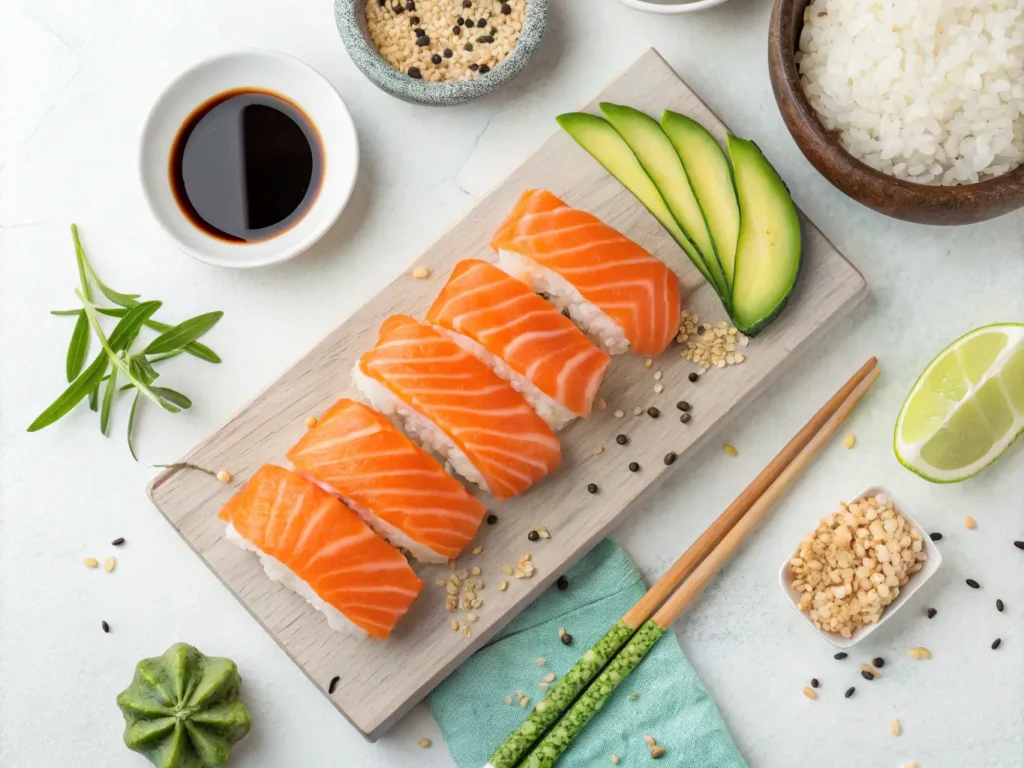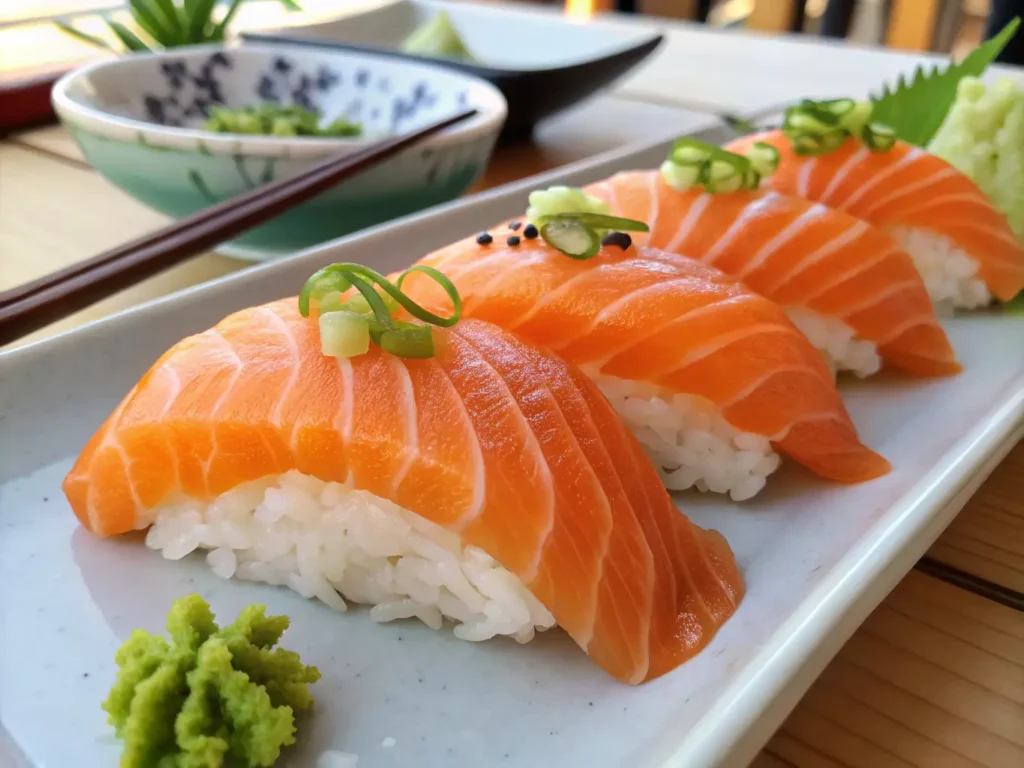Table of Contents
Salmon sushi has become a global sensation, thanks to its delicate flavor, nutritional profile, and versatility. Loved by sushi enthusiasts around the world, this dish originated in Japan and has since captured the hearts of food lovers in various forms—from nigiri to sashimi and even sushi rolls. It’s a dish that’s not only delicious but also packed with health benefits, making it a favorite for those looking to enjoy fresh, clean flavors in a meal.
The beauty of salmon sushi lies in its simplicity. By using the freshest ingredients and following a few key techniques, anyone can create a restaurant-quality sushi experience at home. Whether you’re an experienced sushi chef or a beginner, this guide will provide you with everything you need to know to make perfect salmon sushi every time.
From the basics of sushi rice preparation to perfecting your rolling techniques, this article will cover it all. Get ready to dive into the world of salmon sushi and discover how to make this delicious treat in your kitchen with ease.
What is Salmon Sushi?
Definition and Key Characteristics
Salmon sushi is a traditional Japanese dish made with raw salmon, sushi rice, and nori (seaweed). In fact, this versatile dish offers various ways to prepare it, each providing a unique experience. Thanks to its freshness and simplicity, salmon is the ideal choice for sushi lovers. At its core, salmon sushi features a slice of raw salmon placed on top of a mound of seasoned sushi rice, resulting in a combination known as nigiri.
When making salmon sushi, focus on the quality of the ingredients. Use sushi-grade salmon, which has undergone freezing to eliminate parasites. Make sure to season the rice perfectly to complement the subtle flavor of the fish.
Types of Salmon Sushi
Salmon sushi can be served in various forms, each offering a different taste and texture. These variations include:
- Nigiri: A traditional style of sushi where a slice of fresh salmon is placed on top of a mound of vinegar-seasoned rice. A small dollop of wasabi may be added between the salmon and rice for extra flavor.
- Sashimi: Sliced raw salmon served without rice, offering a pure and unadulterated taste of the fish. Sashimi is typically served as an appetizer or as part of a larger meal.
- Maki Rolls: Salmon is often used in sushi rolls (maki), where it’s rolled up with nori, rice, and various fillings like avocado, cucumber, or cream cheese. This style is especially popular in Western countries.
- Chirashi: A bowl of sushi rice topped with a variety of raw fish, including salmon sashimi, and garnished with vegetables. This style is less common but offers a fantastic way to enjoy multiple types of fish with a satisfying texture.
Why Salmon is a Popular Sushi Ingredient
Salmon is widely favored for sushi for several reasons:
- Flavor: It has a delicate yet slightly sweet flavor, which is ideal for sushi. Unlike fish like tuna, which can be quite rich and overwhelming, salmon provides a balanced taste that pairs beautifully with vinegar-seasoned rice.
- Texture: The flesh of salmon is tender and fatty, making it ideal for nigiri and sashimi. Its smooth texture complements the sticky sushi rice, creating a perfect bite every time.
- Health Benefits: Salmon is one of the best sources of omega-3 fatty acids, which are essential for heart health and brain function. Additionally, salmon is high in protein and contains vitamins like B12 and D, making it a nutritious choice for sushi lovers.
Health Benefits of Salmon Sushi
High in Omega-3 Fatty Acids
Salmon is renowned for its omega-3 fatty acids, which play a crucial role in supporting cardiovascular health. These healthy fats also have anti-inflammatory properties that promote overall wellness. The high levels of omega-3s in salmon can help lower blood pressure, reduce the risk of heart disease, and even improve brain function.
High-Quality Protein Source
In addition to healthy fats, salmon is an excellent source of protein. This macronutrient is essential for muscle repair, immune function, and overall body maintenance. Salmon sushi provides a clean, high-quality protein source that will keep you feeling full and satisfied.
Nutrient-Dense Meal
Salmon is rich in essential vitamins and minerals, including Vitamin B12, which supports red blood cell production, Vitamin D, which is crucial for bone health, and selenium, an important antioxidant. Furthermore, salmon contains potassium, which helps balance the body’s fluids and maintain normal cell function.
By choosing salmon sushi, you’re not only treating yourself to a flavorful dish but also fueling your body with nutrients that contribute to your overall well-being.

Ingredients for Salmon Sushi
Core Ingredients
To make salmon sushi, you’ll need the following ingredients:
- Sushi-Grade Salmon: This is the star of the dish. Ensure you choose fresh, sushi-grade salmon to minimize health risks and enhance flavor.
- Sushi Rice: Short-grain rice is essential for sushi because it has a sticky texture that holds together well. It’s important to season the rice with rice vinegar, sugar, and salt.
- Nori: This edible seaweed is used to wrap the sushi rolls, providing a savory contrast to the rice and salmon.
- Rice Vinegar: This vinegar is mixed with sugar and salt to season the rice, giving it a tangy flavor that balances the richness of the salmon.
Optional Fillings and Add-Ins
You can get creative with your salmon sushi by adding fillings like:
- Avocado: Adds creaminess and richness to the sushi rolls.
- Cucumber: Provides a refreshing crunch and complements the soft salmon.
- Cream Cheese: For a creamy texture, especially in rolls like the Philadelphia roll.
- Spicy Mayo: A mix of mayonnaise and sriracha for a spicy kick.
Dipping Sauces and Toppings
- Soy Sauce: The classic dipping sauce for sushi. It adds a salty flavor that enhances the taste of the fish.
- Wasabi: A pungent, green paste made from Japanese horseradish that adds heat to your sushi.
- Pickled Ginger: Served alongside sushi, pickled ginger helps cleanse the palate between bites.
- Sesame Seeds: These add a nutty flavor and decorative touch to your sushi.
Equipment Needed to Make Salmon Sushi
Essential Tools
- Bamboo Sushi Mat: The bamboo sushi mat is an indispensable tool for making sushi. It helps you roll the sushi tightly and evenly, ensuring that your rolls hold together without falling apart. The mat provides gentle yet consistent pressure to create perfectly shaped rolls, whether you’re making maki or other types of sushi.
- Sharp Knife: A sharp knife is essential for slicing both salmon and sushi rolls cleanly. It helps you achieve precise cuts, ensuring that the delicate fish slices and sushi rolls are smooth and neat. A dull knife can tear the fish and rice, ruining the presentation and texture. Make sure to use a sushi knife or a high-quality chef’s knife for the best results.
- Rice Paddle: The rice paddle is used to handle sushi rice without mashing or clumping it. This tool is ideal for gently mixing the rice with the vinegar seasoning, ensuring that each grain stays intact. It’s also useful for scooping and transferring the rice onto the nori sheets when assembling maki rolls.
Optional Accessories
- Plastic Wrap: If you don’t have a bamboo sushi mat, you can use plastic wrap as a makeshift tool for rolling. Lay a sheet of plastic wrap on a flat surface and place the nori on top. Then, roll as you would with the mat, using your hands or the wrap to apply pressure. While this method is slightly less efficient, it works well in a pinch.
- Small Bowls for Water: Keep small bowls of water nearby to wet your hands while working with sushi rice. This prevents the rice from sticking to your hands and allows you to handle it more easily. Additionally, a small bowl of water is handy for sealing the nori when rolling and ensuring that the edges stick together properly.
- Chopsticks: Chopsticks are the traditional utensils used for both serving and eating sushi. They allow you to delicately pick up your sushi rolls and nigiri without disturbing the structure. Having a pair of chopsticks on hand enhances the authentic dining experience when serving salmon sushi at home.
Step-by-Step Instructions for Making Salmon Sushi
1: Preparing the Rice
- Rinse the sushi rice under cold water until the water runs clear to remove excess starch.
- Cook the rice according to the instructions on the package. Once cooked, let the rice cool slightly.
- Mix rice vinegar, sugar, and salt in a small bowl and gently stir into the rice while it’s still warm.
- Let the rice cool to room temperature before using it for making sushi.
2: Prepping the Salmon
Start by slicing your sushi-grade salmon into thin, even pieces. These slices will be used for both nigiri and sashimi. For maki rolls, however, cut the salmon into long strips, which will serve as the main filling of the rolls. Ensure the slices are thin yet sturdy, so they can sit comfortably on top of the rice or roll tightly in the nori.
3: Rolling Maki (Salmon Sushi Rolls)
- Place a sheet of nori on your bamboo sushi mat, with the shiny side facing down. This is the side that will be in contact with the rice.
- Wet your hands with a little water to prevent the rice from sticking to your fingers. Spread a thin layer of sushi rice evenly across the nori, leaving a small border at the top. This ensures the rice doesn’t spill out when you roll.
- Add the salmon strips at the bottom of the rice, and if you’re using any other fillings, like avocado or cucumber, place them alongside the salmon for added texture and flavor.
- Carefully roll the sushi, using the bamboo mat to apply gentle yet firm pressure as you roll from the bottom to the top. Keep the roll tight but not too tight, ensuring it holds together without crushing the ingredients inside.
- Seal the edge of the nori with a little water, using your fingers to press it down firmly to prevent the roll from unraveling.
4: Making Salmon Nigiri
- Shape small mounds of sushi rice into oval shapes with your hands. This rice should be sticky enough to hold together but not mushy.
- Lay a slice of salmon on top of each rice ball. If you like a little extra kick, optionally add a small amount of wasabi between the salmon and rice before placing it on top. This adds an authentic, spicy zing to your nigiri.
5: Serving the Sushi
- Arrange your sushi on a clean plate, making sure it’s visually appealing and evenly spaced for a polished presentation.
- Garnish with pickled ginger on the side, along with a small dollop of wasabi for those who enjoy an extra kick. Sprinkle sesame seeds over the top of the nigiri or maki rolls for added texture and visual appeal.
- Serve the sushi with soy sauce for dipping, allowing everyone to enjoy the full range of flavors with each bite.
Tips for Perfect Salmon Sushi
Selecting Sushi-Grade Salmon
For safety and the best flavor, always use sushi-grade salmon. It’s important that the salmon has been properly frozen to eliminate any parasites, making it safe to eat raw.
Perfecting the Rice
Achieving the right texture for your sushi rice is crucial. It should be sticky enough to hold together but not mushy. The seasoning of the rice with rice vinegar, sugar, and salt is essential for achieving the traditional sushi flavor.
Mastering the Rolling Technique
Rolling sushi can take practice. Apply even pressure while rolling to ensure the sushi stays together without being too tight or too loose. Practice makes perfect!

Variations of Salmon Sushi
Classic Salmon Nigiri
The simplest form of salmon sushi, consisting of vinegar-seasoned rice topped with a thin slice of raw salmon.
Spicy Salmon Roll
A popular variation that combines spicy mayo and salmon, often accompanied by avocado and cucumber for added texture.
Philadelphia Roll
A sushi roll made with smoked salmon, cream cheese, and cucumber, offering a creamy and savory flavor profile.
Dragon Roll
A deluxe roll featuring salmon, eel, avocado, and tempura shrimp—a true showstopper.
Salmon Sashimi
Thinly sliced raw salmon served without rice, highlighting the purity and natural flavor of the fish.
Serving Suggestions for Salmon Sushi
Best Accompaniments
Pair your sushi with miso soup, seaweed salad, or edamame for a well-rounded meal.
Presentation Tips
Arrange your sushi in an artistic pattern, garnished with edible flowers or microgreens to enhance the visual appeal.
Beverage Pairings
Serve green tea, sake, or sparkling water to complement the subtle flavors of the sushi.
Health and Safety Tips
Ensuring Freshness and Quality
To ensure safety, always use sushi-grade salmon and store it in the refrigerator until ready to use. For optimal freshness, purchase your fish from a trusted source.
Food Safety for Raw Salmon
Raw fish should always be handled with care. Keep your tools and workspace clean to prevent contamination.
Using the Right Equipment
Invest in a sharp knife to slice the salmon cleanly and a bamboo sushi mat for easy rolling.
Common Mistakes to Avoid
Using Non-Sushi Grade Salmon
Never use regular salmon for sushi. Only sushi-grade salmon is safe to consume raw.
Overcooking or Undercooking Rice
The rice should be slightly sticky but not mushy. Follow instructions carefully to avoid overcooking or undercooking.
Rolling Too Loose or Too Tight
For perfect sushi rolls, don’t roll too tight or too loose. The sushi should stay together without falling apart.
FAQs
Can I use frozen salmon for sushi?
Yes, as long as it is sushi-grade and has been frozen to kill any parasites.
What’s the difference between sushi-grade and regular salmon?
Sushi-grade salmon is safe to eat raw, while regular salmon may not be.
How do I make sushi without a bamboo mat?
You can use plastic wrap or even a towel to roll the sushi.
How long can I store leftover salmon sushi?
Leftover sushi is best consumed within a few hours but can be stored in the fridge for up to 24 hours.
Can I make salmon sushi without rice?
Yes, you can enjoy salmon sashimi without the rice.
Conclusion
Making salmon sushi at home is both a fun and rewarding experience. With the right ingredients, techniques, and a little practice, you can create restaurant-quality sushi that’s as fresh and flavorful as what you’d enjoy at your favorite sushi bar. Whether you prefer nigiri, sashimi, or maki rolls, sushi is an incredibly versatile dish that allows you to experiment with different ingredients and flavors. We highly encourage you to try making sushi at home and discover just how easy and delicious it can be. Enjoy the process and savor the results!

